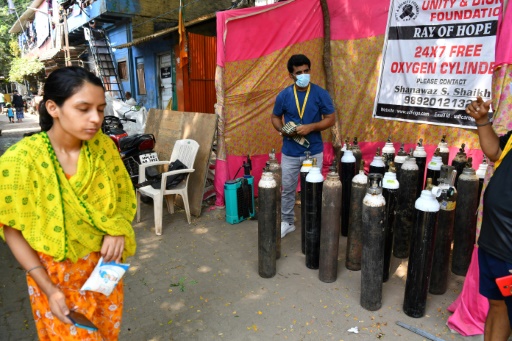Her exam revisions completed, Swadha Prasad, a student in Bombay, immediately devoted herself to her mission: saving lives by unearthing oxygen, drugs and places in hospitals for Covid-19 patients.
Sawdha Prasad works with dozens of volunteers, as part of the UNCUT organization, founded by young people aged 14 to 19.
As the Indian government struggles to meet the needs of a saturated health system, these young Indians have taken action by creating apps to collect and deliver urgent aid.
They use social media to channel medical resources to direct them to people in danger.
– Cadence of three eights –
They act 24 hours a day, 7 days a week, constantly connected to social networks and their phones, checking the availability of medical help, updating information in real time and responding to calls from adults in distress. .
“Some of us work from midnight until dawn because the calls don’t end at three in the morning,” says the 17-year-old, who struggles every day from noon to one in the morning.
It is a physically and morally trying task, admits the student, but the stakes are eminently vital.
“If I can help save a life, there isn’t a part of me that can say + no +,” she says.
In fact, lives have been saved, she assures, referring to the case of this young patient with Covid-19 to whom a team was able to provide oxygen in the middle of the night, after two hours of terrifying wait.
But “it’s not just about material resources (…) sometimes people just need to know that they are not alone,” she continues.
– “Oxygen man” –
Two-thirds of India’s population of 1.3 billion is under the age of 35.
All this youth had never been called upon to assume such important responsibilities.
While India seems to have capsized in the midst of a dystopia, with crematoriums running at full speed and patients dying at the gates of saturated hospitals, many young people want to make a difference.
In the slums of Bombay, Shanawaz Shaikh provides free oxygen.
Nicknamed “Oxygen man”, like a super hero, this 32-year-old man sold his SUV in June to finance this initiative after the death of a pregnant friend, sick of Covid-19, in the back of a tuk- tuk in front of the hospital where she hoped to be admitted.
“She died because she did not receive oxygen in time,” he told AFP.
He didn’t expect to have to respond to so many requests almost a year later. “Last year, we received around 40 calls a day, now it’s more like 500!”
Its team of 20 volunteers is struggling to find oxygen in this context of scarcity, made worse by black market profiteers.
“It’s a test of faith,” he said, describing his difficult quest for oxygen to save breathless patients.
“When I succeed in helping someone, I feel like crying.”
– What about the countryside? –
While big cities have been hit the hardest so far, technology and social media are reaching their limits as the virus infiltrates small towns and rural villages, Umang tells AFP. Galaiya.
The 25-year-old computer engineer has created an app that makes it easier for users to find what they’re looking for and, most importantly, to limit their search to verified resources.
But as effective as its application, it does not help people outside the big cities, he regrets, citing the example of his hometown in the state of Gujarat (north-west), also hard hit. by the epidemic.
“If I look for resources at Jamnagar via Twitter, no proposal comes out,” he said.
This pandemic cannot be defeated without government action, he concludes by suggesting some simple measures that could still save many lives, such as creating an online registry of available hospital beds, which is automatically updated, in real time.
“If we can do it for theaters, to avoid overbooking, why can’t we do it for hospitals?” /
–


